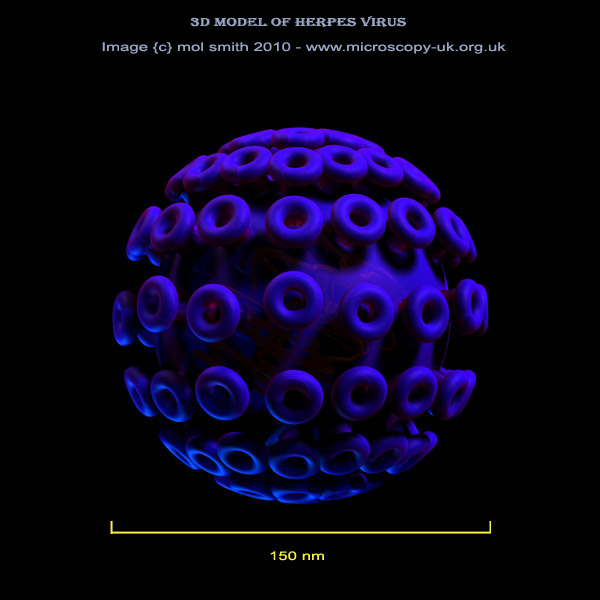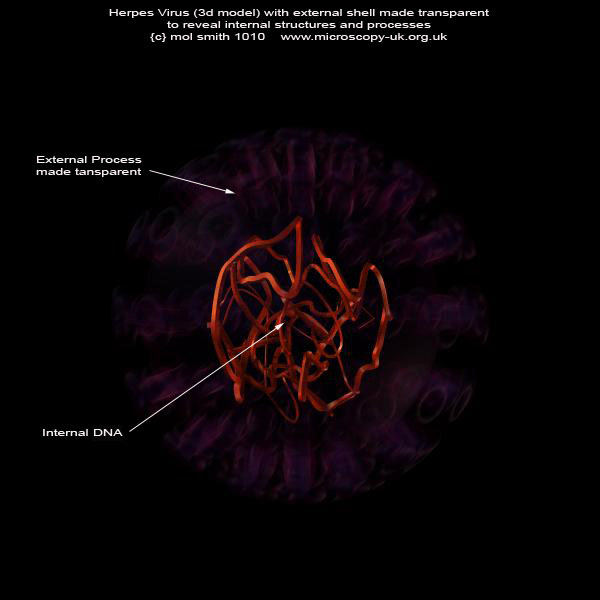|
The Herpes Virus
This is a good 3D model of the Herpes
Simplex Virus. one of the herpes virus family, Herpesviridae, that infect humans. There is no known cure for HSV
infection. All Animal herpes viruses share these properties: a large double-stranded, linear DNA genome, encased
within an icosahedral protein cage called the capsid. The envelope encapsulating the virus particle and DNA, when
bonded to specific receptors on the cell's surface, will weld with the host cell membrane and then create a tiny
opening through which the virus DNA contents can be introduced (invade) the host cell.

The Herpes virus is symmetrical and looks the same
globally, as you can see in the animated rotation above.

In this render of a 3D model above, I have made
the external capsoid transparent, so you can clearly see the single DNA strand inside. If you wish to see a SEM image of a Herpes Virus invading a cell, take a look at Dennis Kunkel's image, in this off-site
link here: http://www.denniskunkel.com/DK/Viruses/11454A.html
Where Do Viruses Come From?
No one knows for sure how viruses originated. Three different theories exist:
Regressive hypothesis
Viruses may have once been smaller cells that parasitised larger ones. In time, their parasitism were lost and
the virus was able to 'stand-alone' but not reproduce without the appropriate cell DNA/RNA nucleus factory. The
bacteria rickettsia and chlamydia cells that, like viruses, can reproduce only inside host cells. They lend support
to this hypothesis. This is also called the degeneracy hypothesis.
Cellular origin hypothesis
Some viruses may have evolved from ' vagrant' bits of DNA or RNA that 'escaped' or leaked from the genes of cells
or organisms. The escaped DNA could have come from plasmids (pieces of naked DNA that can move between cells) or
transposons (molecules of DNA that replicate and move around to different positions within the genes of the cell).This
is sometimes called the vagrancy hypothesis.
Co-evolution hypothesis
Viruses may have simply evolved from complex molecules of protein and nucleic acid in parallel and at the same
time that cells first appeared on earth.
Although a very controversial theory with very little widespread support, there is also the idea that living organisms
( and therefore possibly
also viruses as simpler semi-living molecular structures,
{authors addition} )
were introduced to
the early Earth by a process called Panspermia: in simple
terms - the hypothesis that life on Earth originated from microorganisms from outer space, possibly through the
ice-dust clouds of comet tails crossing the Earth's orbital path. There is also the idea that viruses could also
have evolved from previous viruses, which doesn't solve their origin, but may account for their large variance
and wide diversity. The whole area of Virus origin is highly speculative, not least of course because they cannot
leave fossil traces to help us prove their journey down through time.
Classification
Viruses (also called Bacteriophages where their host are bacteria) can be classified through properties like host
cell range and immunological relationships but the most important characteristics are phage morphology and nucleic
acid properties. Genetic material may be DNA or RNA. Most viruses have DNA, usually double-stranded, like the Herpes
Virus above. Also, most - but not all - can be placed in one of several morphological groups: tail-less icosahedral
phages, those with contractile tails, those with non-contractile tails, and filament phages. . Viruses exist which
invade animals, cells, plants, and bacteria. Viruses also exist in large numbers in marine environments. There
are also some phages with envelopes, but the most complex ones are those that fall into the group having contractile
tails: the T4 Bacteriophage. Let's take a look at a virus like this and take a closer look at its mechanism for
releasing genetic material into a host cell. The T4 Virus...
|

